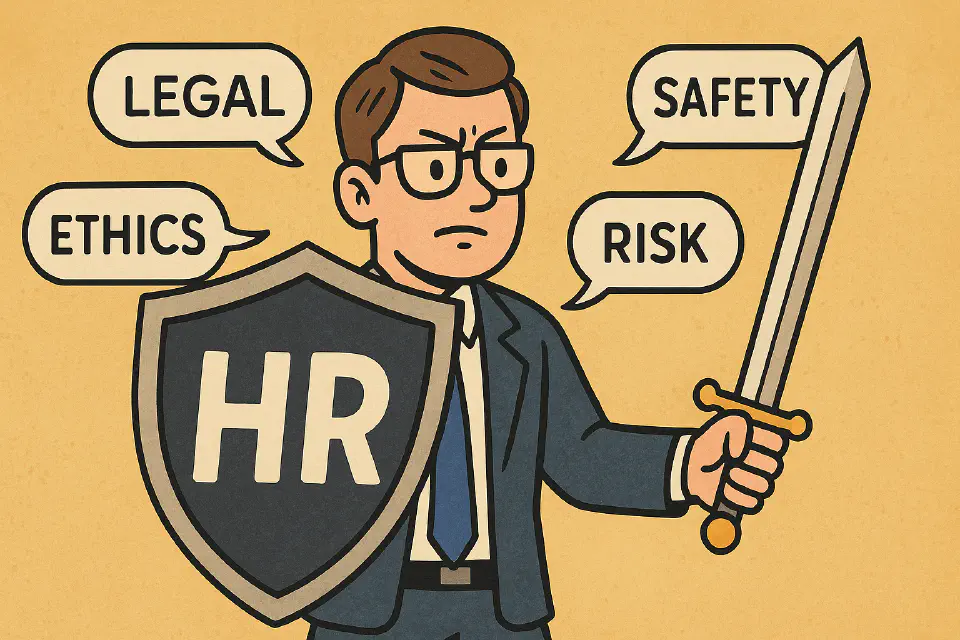
HR as a Risk Manager
HR isn't just about hiring and culture — it's a critical function in identifying and managing risks that can impact reputation, compliance, workforce stability, and even long-term survival. This page explores how HR professionals act as risk managers across all levels of the organization.
Why Risk Management Belongs in HR
When we think of organizational risk, we often picture cyber threats, financial loss, or supply chain disruption. But many of the most significant risks — from ethical scandals to toxic leadership, to unsafe workplaces or employee activism — are people risks. And HR is where people risk lives.
These risks can be both acute (a legal claim, a strike, a whistleblower case) and chronic (low trust, diversity gaps, poor manager capability).
According to PwC’s 2023 Global Risk Survey, 73% of business leaders say people-related risks are more complex than five years ago — and only 31% believe their organizations are effectively managing them.
Core Categories of People-Related Risk
| Risk Area | Examples |
|---|---|
| Compliance & Legal | Breaches of labor law, discrimination, harassment, unsafe conditions |
| Conduct & Ethics | Abuse of power, bullying, corruption, DEI backlash |
| Workforce Stability | High attrition, burnout, quiet quitting, talent hoarding |
| Reputation & Trust | Employer brand damage, social media scandals, employee protests |
| Organizational Resilience | Succession gaps, leadership failure, rigid policies that block adaptation |
HR professionals are often the first line of defense — and sometimes the only function with visibility into these risks before they escalate.
Risk Sits at the Intersection of Systems and People
Organizational risks emerge when structures, incentives, culture, and leadership are misaligned. HR is uniquely positioned to:
- See cross-functional patterns others miss
- Hear employee sentiment before it escalates
- Design structures that mitigate risk (e.g. job rotations, whistleblower channels, policy reviews)
- Support accountability without fear
Mitigation Starts with Visibility
To mitigate people-related risk, HR must see it early, name it clearly, and act on it consistently. That means building channels and tools that make risks visible before they explode:
- Pulse surveys that detect early signs of psychological safety issues
- Exit interviews that flag pattern-based attrition
- Behavioral analytics that identify absenteeism, productivity shifts, or burnout
- Ethics hotlines and whistleblower tools with clear protection protocols
Governance, Escalation, and Role Clarity
Risk management doesn’t work in a vacuum. It requires clear roles and robust governance:
| Role | Responsibility |
|---|---|
| HRBP | Local risk sensing, documentation, and manager coaching |
| Compliance/Legal | Framework setting, escalation, investigation, legal protection |
| People Analytics | Risk modeling, pattern detection, trigger alerts |
| Executive Sponsor | Setting tone from the top, ensuring resourcing and follow-through |
Escalation pathways should be:
- Clearly defined (who escalates, to whom, when)
- Documented in policies and playbooks
- Practiced through simulations (like crisis tabletop exercises)
Behavior-Based Risk Indicators
Many risks don’t arrive with red flags — they accumulate silently. HR should actively monitor behavioral risk indicators:
- Sudden drop in 1:1s or feedback culture
- Declining manager effectiveness scores
- Increase in exit interview mentions of “respect” or “fairness”
- Repeated policy workarounds or exceptions
Succession Risk and Leadership Gaps
One of the most overlooked risk domains in HR is succession planning. When key leaders exit unexpectedly or are unfit for future demands, organizations suffer performance, cultural, and strategic disruption.
To manage leadership risk:
- Maintain and regularly update succession plans (not just for C-levels)
- Build readiness pipelines with structured development paths
- Track flight risk, burnout signals, and bench strength by function
- Include DEI lenses in succession criteria to avoid systemic bias
Whistleblower Channels and Psychological Safety
Encouraging employees to speak up is one of the most effective forms of risk prevention — and one of the hardest to sustain.
To build trusted channels:
- Offer multiple pathways (anonymous hotline, local HR, ombuds)
- Create clear retaliation protections and publish enforcement examples
- Train managers to handle concerns without defensiveness
- Reward ethical behavior, not just business outcomes
Maturity Model: HR Risk Management
| Stage | Characteristics |
|---|---|
| Reactive | HR responds only after legal or PR escalation |
| Aware | Risks are acknowledged but not measured or tracked systematically |
| Structured | HR policies, data, and governance support risk identification |
| Embedded | Risk sensing is built into people processes; culture reinforces prevention |
Embedding Risk Thinking into Everyday HR
Risk management shouldn’t live in a playbook — it should live in decision-making:
- In recruiting: “What signals indicate future misconduct?”
- In promotions: “Does this leader create psychological safety?”
- In engagement: “Where is feedback being withheld or filtered?”
- In policy: “What are the unintended risks of this new rule?”
When HR integrates risk awareness into planning, culture, systems, and relationships — it moves from being a compliance gatekeeper to a strategic protector.
Final Thought
Managing people risk is not about fear — it’s about foresight.
It’s about helping the business move faster and braver because HR has already considered what might go wrong — and built the systems, culture, and safeguards to handle it.
HR doesn’t just reduce risk. It makes risk safe to talk about — and safe to act on.